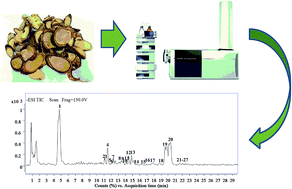Characterization of the major chemical constituents in Ardisia gigantifolia by high performance liquid chromatography coupled to electrospray ionization and quadrupole time-of-flight mass spectrometry
Abstract
The dried root of Ardisia gigantifolia Stapf. (RAG) is mainly used as a Chinese folk medicine. A clear understanding of its major components is very important in their rational clinical use and pharmacological research. To find more of the major components in RAG, a high performance liquid chromatography coupled to electrospray ionization and quadrupole time-of-flight-mass spectrometry method (HPLC-ESI-QTOF-MS/MS) was proposed. The components were characterised based on their accurate mass and MS/MS data provided by the QTOF-MS as well as by comparison with information from the literature. In this study, 27 phytochemical components were tentatively characterised. Notably, out of the 27 components, 8 triterpenoid saponins are new and their chemical structures have been proposed for the first time in RAG. These results showed that the HPLC-ESI-QTOF-MS/MS method was a powerful tool for a comprehensive research of RAG, which could provide a meaningful basis for further quality control and pharmacological as well as toxicological research studies.



 Please wait while we load your content...
Please wait while we load your content...